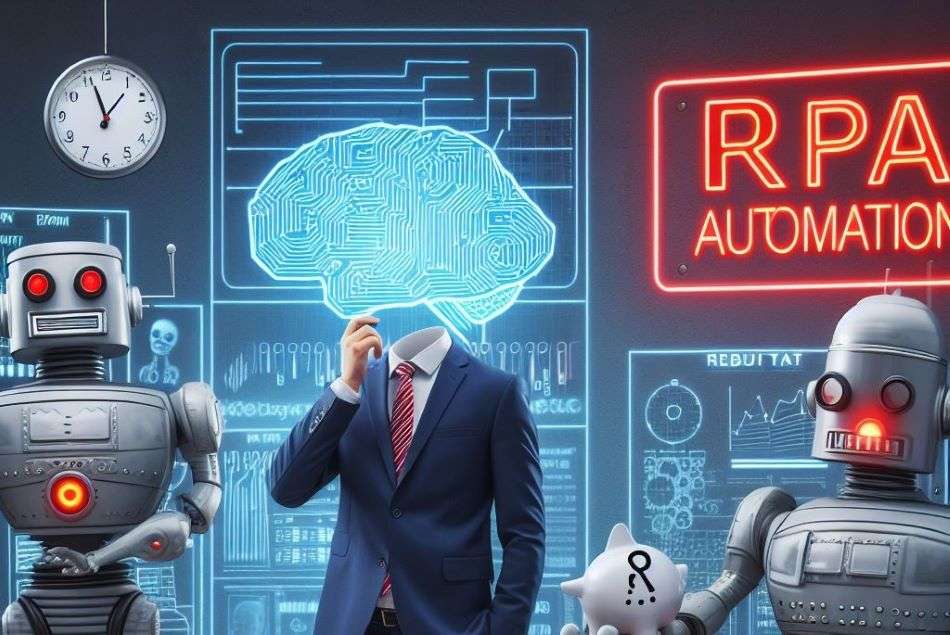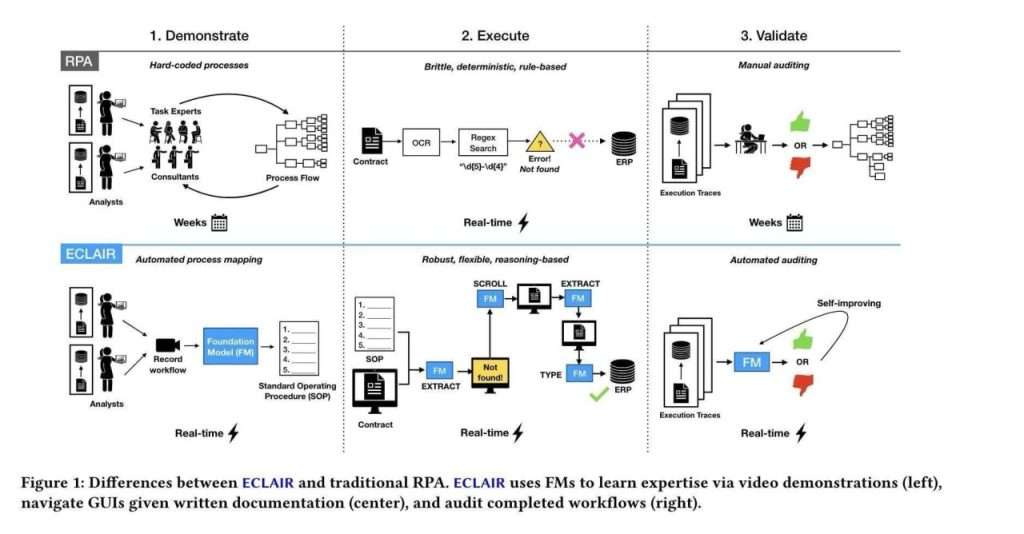ECLAIR – A New AI Enterprise Automation Framework with 94% Accuracy

Tired of your business being bogged down by repetitive tasks, click by click? You’re not the only one. Companies worldwide are losing a shocking $4 trillion every year because of these inefficiencies. But here is a breakthrough: a new framework designed for more effective AI Enterprise Automation: ECLAIR
Developed by Stanford University, ECLAIR is an AI learning framework that’s designed to make business automation smarter and easier. Unlike traditional Robotic Process Automation (RPA), which can be expensive, rigid, and difficult to use, ECLAIR offers a more flexible and efficient approach. The best part? It observes, learn and improve over time.
The Productivity Drain: A $4 Trillion Problem
In business, time is money and time well spent will generate more money. That’s the whole point of automating tedious tasks that have low productivity value. Think about all those hours spent on data entry, invoice processing, report generation – the list goes on and on. It’s not just tedious; it’s a massive drain on productivity and a major obstacle to innovation.
McKinsey, a leading global consulting firm, estimates that a staggering $4 trillion is lost annually due to these inefficiencies. That’s trillions, with a “T”! It’s a mind-boggling figure that underscores the urgent need for effective automation solutions.
Current Automation Method – RPA: Promises vs. Reality

Robotic Process Automation (RPA) is software that automates repetitive, rule-based tasks. Think of it as a digital worker who can interact with your computer systems and applications, just like a human employee would.
While RPA has seen some success, with narrowly scoped deployments boasting ROIs of 30-200% and doubling the speed of workflows, the reality often falls short of expectations.
Challenges with RPA Implementation:
- High setup costs: Implementing RPA can be a costly endeavor, often taking 12-18 months from project kickoff to deployment. It typically requires trained specialists to map workflows, write automation scripts, and integrate with existing IT infrastructure.
- Unreliable execution: RPA bots rely on hard-coded rules, making them inflexible and prone to errors when faced with even slight variations in input. In one case study, an RPA bot initially achieved only 60% accuracy and required six months of fine-tuning to reach 95%.
- Burdensome maintenance: RPA deployments often demand continuous human oversight to validate outputs and fix errors. In another case study, maintaining a single RPA bot required the equivalent of two full-time employees.
How RPA is implemented:
- Process Identification: Identify the tasks that are repetitive, rule-based, and suitable for automation.
- Bot Development: Use RPA software to create bots that can perform these tasks. This can be done by recording your actions or defining a set of rules for the bot to follow.
- Testing and Deployment: Thoroughly test the bots to ensure they work as expected, then deploy them into your existing systems.
Use Cases for RPA:
- Finance and Accounting: Automating invoice processing, accounts payable/receivable, and financial reporting.
- Human Resources: Automating onboarding processes, employee data management, and benefits administration.
- Customer Service: Automating responses to common inquiries, order processing, and complaint resolution.
- Healthcare: Automating patient data entry, claims processing, and appointment scheduling.
While RPA offers potential benefits, it’s important to be aware of its limitations, which include high setup costs, inflexibility, and the need for ongoing human supervision.
ECLAIR – A New Approach to Automating Complex Workflows

ECLAIR, which stands for “Enterprise sCaLe AI for woRkflows,” is a groundbreaking AI framework developed by researchers at Stanford University. It’s designed to tackle the complex challenge of automating intricate business processes that traditional Robotic Process Automation (RPA) struggles to handle.
ECLAIR’s approach is unique. Instead of relying on rigid, pre-programmed rules like RPA, it learns by observing how humans perform tasks. This makes it incredibly adaptable, able to navigate the nuances of real-world workflows and adjust to changes on the fly.
ECLAIR in Action: A Real-World Success Story at Stanford Hospital
ECLAIR isn’t just a theoretical concept; it’s already proving its worth in real-world scenarios. At Stanford Hospital, a renowned medical institution known for its cutting-edge technology, ECLAIR was put to the test in a high-stakes environment.
The challenge was to automate the complex process of placing patient telesitter orders in Epic, the widely used electronic health record (EHR) software. This task involves multiple steps, navigating through various screens and menus, and making critical decisions based on patient information.
ECLAIR’s Impact:
- Seamless Automation: ECLAIR successfully automated this intricate process, navigating multiple screens, menus, and decision points with minimal human intervention.
- Near-Human Accuracy: ECLAIR demonstrated an impressive 93% accuracy rate in identifying the necessary steps within the workflow.
- Double the Efficiency: ECLAIR outperformed even advanced AI models like GPT-4, doubling their completion rate in this complex task. This translates to significant time savings for healthcare professionals.
Beyond Automation: ECLAIR’s Continuous Learning Loop
What sets ECLAIR apart is its ability to learn and improve over time. As it interacts with different workflows and environments, it continuously refines its skills, becoming more efficient and effective. This self-improvement loop ensures that ECLAIR stays ahead in automation technology, adapting to new challenges and evolving alongside the businesses it serves.
The Future of Work: ECLAIR’s Transformative Potential
The implications of ECLAIR’s success at Stanford Hospital extend far beyond the healthcare sector. It shows massive potential and a perspective change on how we approach automation, with the potential to:
- Unlock Trillions in Value: By automating repetitive, time-consuming tasks across industries, ECLAIR can free up employees to focus on higher-value work, such as strategic planning, creative problem-solving, and direct customer interaction. This shift could unlock trillions of dollars in economic value, according to McKinsey.
- Democratize Automation: ECLAIR’s user-friendly set-up and adaptability make it accessible to businesses of all sizes, not just large enterprises with deep pockets. Cheaper, faster and more accurate.
- Transform Industries: ECLAIR’s potential isn’t limited to healthcare. Its ability to automate complex workflows could revolutionize industries like finance, manufacturing, and customer service, streamlining operations and driving innovation.
AI Enterprise Automation – New business opportunities
AI consulting or AI Automation companies that successfully implement ECLAIR Framework in developing faster, cheaper and more effective workflows for enterprises can tap into a once in a lifetime business opportunity – 4 trillion USD industry with limited competition.
Stay on top of AI Education and latest business insights with Tech Pilot by subscribing to our weekly newsletter.




